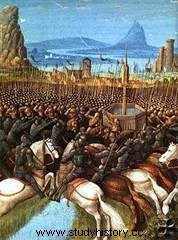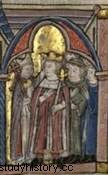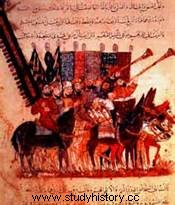 At the Battle of Hattin , on July 4, 1187, Saladin defeated the army of the king of Jerusalem, Guy de Lusignan, and his turbulent ally Renaud de Châtillon at a place called the Horns of Hattin, near Lake Tiberias. The king of Jerusalem surrenders, with some of his knights, and lives, but all the Templars and the Hospitallers of Saint-Jean-de-Jérusalem are beheaded near the battlefield. This is the last step in the reconquest of Jerusalem begun by Saladin since he succeeded in unifying the Muslims under the banner of jihad. The Crusader army exterminated at Hattin, the Holy City will fall like a ripe fruit on October 2, 1187.
At the Battle of Hattin , on July 4, 1187, Saladin defeated the army of the king of Jerusalem, Guy de Lusignan, and his turbulent ally Renaud de Châtillon at a place called the Horns of Hattin, near Lake Tiberias. The king of Jerusalem surrenders, with some of his knights, and lives, but all the Templars and the Hospitallers of Saint-Jean-de-Jérusalem are beheaded near the battlefield. This is the last step in the reconquest of Jerusalem begun by Saladin since he succeeded in unifying the Muslims under the banner of jihad. The Crusader army exterminated at Hattin, the Holy City will fall like a ripe fruit on October 2, 1187.
The context of the Battle of Hattin
 Since the death of the king of Jerusalem Baldwin IV, says the leper, in 1185 the Latin kingdom is in full decline . The behind-the-scenes maneuvers of Guy de Lusignan and his wife Sibylle allow the former to ascend the throne of Jerusalem, following the early death of the young Baudouin V. With the help of Renaud de Châtillon, and against the advice of the regent Raymond, Count of Tripoli, the new protector of the Holy Sepulcher decides to resume hostilities with Saladin, who had signed a two-year truce with the leper king and the regent. True to his habits, which earned him the name of the Elephant, Baron Renaud de Châtillon violated the truce by attacking a caravan that had left Cairo at the end of 1186. This was too much for Saladin, who decided to march on the Latin kingdom.
Since the death of the king of Jerusalem Baldwin IV, says the leper, in 1185 the Latin kingdom is in full decline . The behind-the-scenes maneuvers of Guy de Lusignan and his wife Sibylle allow the former to ascend the throne of Jerusalem, following the early death of the young Baudouin V. With the help of Renaud de Châtillon, and against the advice of the regent Raymond, Count of Tripoli, the new protector of the Holy Sepulcher decides to resume hostilities with Saladin, who had signed a two-year truce with the leper king and the regent. True to his habits, which earned him the name of the Elephant, Baron Renaud de Châtillon violated the truce by attacking a caravan that had left Cairo at the end of 1186. This was too much for Saladin, who decided to march on the Latin kingdom.
For its part, Ayyûbide has indeed a free hand. He succeeded in uniting the Muslims, after several years of struggle against the descendants of Nûr al-Dîn, and now controls Aleppo as well as Damascus and Cairo, where he deposed the Fatimids more than ten years ago. Saladin built his legitimacy on jihad-oriented propaganda for the reconquest of Jerusalem. For years, he tried in vain to break through the defenses of the Latin kingdom, defended by Baudouin IV and the military orders, such as the Templars. Hampered by the divisions within his camp and by Frankish skill, he knew how to be patient. The death of the leper king, whom he respected, and the provocations of Renaud de Châtillon therefore come at the right time.
Saladin against the Templars
As early as March 1187, Saladin set out from Damascus with an army of between fifteen and twenty thousand men. He ravages the surrounding lands, and attracts the Crusader troops towards him. These are diminished by years of raids by the sultan throughout the kingdom, and by the divisions that have bled him. However, we can always count on the Templars, led by Gérard de Ridefort… This one attacks a Muslim vanguard of seven thousand horsemen with barely two hundred knights! The Battle of Cresson (1 st May 1187) was obviously a massacre, and only the Master and three other Templars survived...
 A character is in a very bad position:Raymond of Tripoli. The count is torn between his agreements signed with Saladin, and the allegiance he owes as a Frankish prince to the King of Jerusalem. While trying to delay the deadline, the Count of Tripoli must definitively switch to the Latin side, following the Battle of Cresson, which took place on his land. However, he does not intend to let Guy de Lusignan, Renaud de Châtillon and Gérard de Ridefort do anything...
A character is in a very bad position:Raymond of Tripoli. The count is torn between his agreements signed with Saladin, and the allegiance he owes as a Frankish prince to the King of Jerusalem. While trying to delay the deadline, the Count of Tripoli must definitively switch to the Latin side, following the Battle of Cresson, which took place on his land. However, he does not intend to let Guy de Lusignan, Renaud de Châtillon and Gérard de Ridefort do anything...
The opposing forces
In the early days of July 1187, both sides are ready for the decisive battle. It remains to be seen where it will take place and above all who will have the initiative. On the Frankish side, the Military Orders provided around six hundred knights, but those killed at Cresson were lacking. The rest of the army of Jerusalem numbers a little more than fifteen thousand men. The fine flower of the nobility and the Frankish knights are present:King Guy de Lusignan, the Count of Tripoli, Renaud de Châtillon, the Master of the Templars Gérard de Ridefort, or even Guillaume de Montferrat.
Saladin, on the other hand, clearly has the advantage. He could field more than twenty thousand men, half of them cavalry, including the famous mounted archers, a nightmare for heavy Frankish cavalry. To this numerical advantage, the sultan soon adds initiative and control of the terrain.
The course of the Battle of Hattin (July 4, 1187)
Saladin decides to lure the Latins into a trap by attacking Tiberias on July 2. The city is besieged, and with it the wife of the Count of Tripoli. However, the latter seems to have tried to dissuade King Guy de Lusignan from counter-attacking to free the city and his wife. He knows Saladin and the danger, and anyway we do not know if he was sure of the presence of his wife in the besieged city.
Be that as it may, on the evening of July 2, the Crusader army did not set out for Tiberias. This is when Gérard de Ridefort comes on the scene – again. The Master of the Templars, moved by a real hatred of Islam, would have persuaded Guy de Lusignan to break camp, and set out with his entire army to definitively crush the Saladin threat.
The next day, to the great surprise (and for some fear) of the knights and soldiers of Jerusalem, the order is given to leave, direction Tiberias. The climatic conditions are hellish, and the Crusader army already far from its sources of supply. Going forward in this way carries great risks. This does not make Guy and Gérard de Ridefort change their minds, despite the last attempts of Raymond de Tripoli who must, as a good vassal, join the army.
 For his part, Saladin obviously did not lose sight of the Frankish army, and he soon sent his light cavalry harass it. The Latins, however, hoped to reach the city, and thus the lake, to refuel. But, for that, they have to cross a rocky plateau, located between two hills, the famous Horns of Hattin, a basaltic peak. The searing heat and the arrows of the Muslim archers transform the army of the Kingdom of Jerusalem into a disorganized and exhausted mass, which soon finds itself facing Saladin's twenty thousand men, them well supplied and in full force.
For his part, Saladin obviously did not lose sight of the Frankish army, and he soon sent his light cavalry harass it. The Latins, however, hoped to reach the city, and thus the lake, to refuel. But, for that, they have to cross a rocky plateau, located between two hills, the famous Horns of Hattin, a basaltic peak. The searing heat and the arrows of the Muslim archers transform the army of the Kingdom of Jerusalem into a disorganized and exhausted mass, which soon finds itself facing Saladin's twenty thousand men, them well supplied and in full force.
Then it's a hell of a lot, at the exit of the Horns of Hattin. Saladin had the brushwood set on fire, and the crusaders were thus blinded and suffocated by the smoke and the furnace. They receive volleys of several thousand arrows and are unable to react. Only some of them, including Raymond of Tripoli, managed to flee towards Tyre. The rest find themselves in the evening dead on the burning plateau, or trapped in the fortress of Tiberias… The battle of Hattin is over.
Frankish army annihilated at Hattin
The next day, the king of Jerusalem and his retinue went to Saladin. He kills Renaud de Châtillon with his own hand, to punish him for his (many) crimes against Islam. The sultan also executed all the Templars still alive, while Gérard de Ridefort seems to have been killed during the battle. Similarly, the Turkoples, judged as traitors to Islam, were beheaded. Guy de Lusignan meanwhile, saved by his rank, is taken prisoner, just like the other Frankish barons, from whom Saladin can hope for a ransom. The others are reduced to slavery.
Most of the Frankish army was annihilated on July 4, 1187, at Hattin. Only a few garrisons remain in the fortresses and the main cities. This is insufficient to stop Saladin who, in the following weeks, takes the Latin places one by one. Soon only Tire and Jerusalem remain. The latter, the goal of Saladin's jihad, finally fell on October 2, 1187, without any real resistance, defended by a handful of knights, including Balian of Ibelin. Saladin can celebrate his triumph:he has accomplished his duty as a Muslim sovereign, and above all established his personal power over the ummah, even overshadowing the Caliph of Baghdad...
Bibliography
- J. Phillips, A Modern History of the Crusades, Flammarion, 2010.
- A-M. Eddé, Saladin, Flammarion, 2008.- J. Prawer, History of the Latin Kingdom of Jerusalem, CNRS editions, 2007 (republished).
- “The Crusades. The East facing the West”, in Les Cahiers de Science &Vie, 123, June-July 2011.
